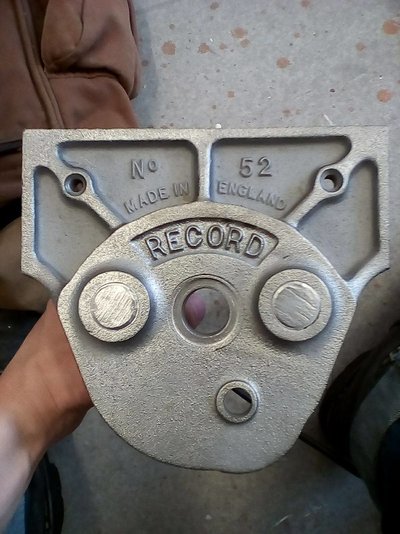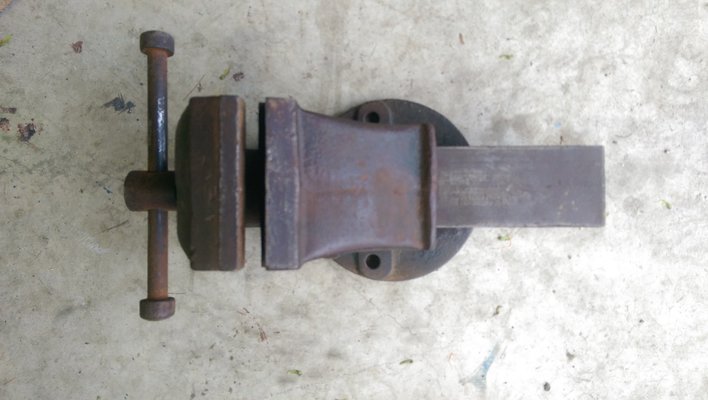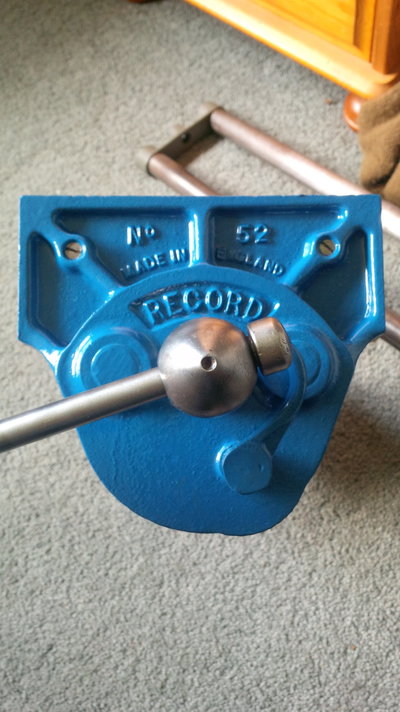You are using an out of date browser. It may not display this or other websites correctly.
You should upgrade or use an alternative browser.
You should upgrade or use an alternative browser.
Show us your bench vice(s)
- Thread starter MattF
- Start date
Brass bristle brush and lashings of water, (it's extremely good at penetrating. Just has the downside of promoting rust), light oil, WD40 or similar, and plenty of elbow grease with the brush.
Would a knotted brass wire cup on an angle grinder be too much?
Only one way to find out.
Fair one! I don’t really like old vices that have been painted up to look new so I’ll probably just wire wheel it then wipe it down with boiled linseed oil for that bare metal look. Would be nice if I could retain the remnant of the old paint though
Dieselman 63
Forklift Certified
- Messages
- 5,681
- Location
- Wellington, New Zealand
I've sheared the end off the screwdriver bit using that method, if the impact driver method doesn't work for me I usually just build up a blob with the tig welder and then weld a nut on. That has never failed and once removed I cut the nut off and recut the screw slot.
I like the record 34/35/36 but I have seen one on ebay that was broken and one of my 36's was bent when I bought it. I think the broken 36 is posted earlier in this thread.
EDIT: Found the broken one picture http://www.mig-welding.co.uk/forum/threads/show-us-your-bench-vice-s.52872/page-25#post-655192
That backbone bit isn't the anvil - look at how much clout it's been given! Someone's actually been using a cold chisel on it! The nail in place of the taper pin says a little about the owner... most engineering merchants will give you one for free. I wonder if Record-Irwin honoured the original 'unbreakable or replacement' statement...
Dieselman 63
Forklift Certified
- Messages
- 5,681
- Location
- Wellington, New Zealand
May also be worth running a file over the back of the insert to see if they're fully hardened throughout. If not, try filing the back faces. Easier to get a flat surface with the file than going the belt sander route.
Unless he's referring to the curve of the cast? In which case you probably shouldn't grind that as it provides the shelf for the jaws to sit on.
MattF
Forum Supporter
- Messages
- 16,929
- Location
- South Yorkshire
Just have at the machined surfaces first, and then apply a lighter touch to painted areas. Some liquid on there will make it less coarse/abrasive whilst brushing/wire wheeling too.
Personally, I don't mind fresh paint too much. Depends on the original condition more than owt. I'd rather lose paint than retain any notable amount of rust. Never been a fan of shining the bare metalwork up though. That really does make anything lose any appearance of age.
Personally, I don't mind fresh paint too much. Depends on the original condition more than owt. I'd rather lose paint than retain any notable amount of rust. Never been a fan of shining the bare metalwork up though. That really does make anything lose any appearance of age.
Dieselman 63
Forklift Certified
- Messages
- 5,681
- Location
- Wellington, New Zealand
Just have at the machined surfaces first, and then apply a lighter touch to painted areas. Some liquid on there will make it less coarse/abrasive whilst brushing/wire wheeling too.
Personally, I don't mind fresh paint too much. Depends on the original condition more than owt. I'd rather lose paint than retain any notable amount of rust. Never been a fan of shining the bare metalwork up though. That really does make anything lose any appearance of age.
Then you'll hate this - fresh from the sandblaster and wire wheel at uni a few months ago
MattF
Forum Supporter
- Messages
- 16,929
- Location
- South Yorkshire
Then you'll hate this - fresh from the sandblaster and wire wheel at uni a few months ago
 One of the first ever things I restored, I had blasted. Still regret it to this day. Different strokes though. Some like it, some don't. I just happen to fall into the latter camp.
One of the first ever things I restored, I had blasted. Still regret it to this day. Different strokes though. Some like it, some don't. I just happen to fall into the latter camp.Dieselman 63
Forklift Certified
- Messages
- 5,681
- Location
- Wellington, New Zealand
One of the first ever things I restored, I had blasted. Still regret it to this day. Different strokes though. Some like it, some don't. I just happen to fall into the latter camp.
I'm not a fan either - this lasted all of ten minutes before it went into primer.
I think there's a point where you have to say preserve or full restore. Most of the stuff I get is in the latter camp, the only exception being a lovely little 6" Wolf grinder which has about 90% of the original paint so I've left it as is. The Harrison grinder on the other hand has had about seven repaints in its life and there's rot under the old filler. There was only one choice there - full resto.
MattF
Forum Supporter
- Messages
- 16,929
- Location
- South Yorkshire
That's pretty much the crux of it. I have an old lathe outside which I'd like to retain paint & a stylised, painted identification number upon it, but it's so rusty, (came from a collapsed shed), there's no feasible way to restore without the paint going. I always look at it this way; Better to preserve the equipment itself, over the finish. Needs must.
CwazyWabbit
Member
- Messages
- 699
- Location
- Surrey, UK
I find it quite amusing that whilst the back of the vice has been given loads of abuse the anvil itself appears relatively unused...That backbone bit isn't the anvil - look at how much clout it's been given! Someone's actually been using a cold chisel on it! The nail in place of the taper pin says a little about the owner... most engineering merchants will give you one for free. I wonder if Record-Irwin honoured the original 'unbreakable or replacement' statement...
Hit my ‘new’ no.24 with a wire wheel and it’s come up nicely

All came apart with no trouble. Didn’t bother taking the jaws off as one of the screws looked a little chewed, plus they are in good nick so can stay on.
After a wire brush and coating of WD40:

Will leave it as is until my linseed oil arrives where I’ll degrease it and apply a light coat, not going to paint. Inside The main body there’s still a little bit of hard to reach dirt so might give it a bath in some engine degreasant at some point as it think it’s just ancient lube.
Found this little stamp on part of the QR mech:

Looks like it’s 94 years old!
All came apart with no trouble. Didn’t bother taking the jaws off as one of the screws looked a little chewed, plus they are in good nick so can stay on.
After a wire brush and coating of WD40:
Will leave it as is until my linseed oil arrives where I’ll degrease it and apply a light coat, not going to paint. Inside The main body there’s still a little bit of hard to reach dirt so might give it a bath in some engine degreasant at some point as it think it’s just ancient lube.
Found this little stamp on part of the QR mech:
Looks like it’s 94 years old!
Asphalt70
Member
- Messages
- 36
- Location
- Denmark
I'm only talking about jaws and where they are mounted. I dont want it machined on top curve of cast. (It would be a hard job to file the steel cast straight). Actually on the no.75, the curve on the top are one of the ways to decide its age. Old ones have a radius and newer ones are straight on top.Unless he's referring to the curve of the cast? In which case you probably shouldn't grind that as it provides the shelf for the jaws to sit on.
Right now I'm waiting for my friend to get to the machining og the "shelf" and hopefully the jaws to if not to hard...a little bit sorry not to have acces to all kind of machines like in the old days.
Asphalt70
Member
- Messages
- 36
- Location
- Denmark
I normally dont like the all naked ones for the same reasons as Matt. What I mostly do like is one with old paint like my no.75Fair one! I don’t really like old vices that have been painted up to look new so I’ll probably just wire wheel it then wipe it down with boiled linseed oil for that bare metal look. Would be nice if I could retain the remnant of the old paint though
Its got original red paint, blue, green but most silver.
I like to imagine all the work put into former paint jobs. Same as the history all the scars show.
My first plan was to strip and paint...in this case I'm happy I didnt.
Dieselman 63
Forklift Certified
- Messages
- 5,681
- Location
- Wellington, New Zealand
I'm only talking about jaws and where they are mounted. I dont want it machined on top curve of cast. (It would be a hard job to file the steel cast straight). Actually on the no.75, the curve on the top are one of the ways to decide its age. Old ones have a radius and newer ones are straight on top.
Right now I'm waiting for my friend to get to the machining og the "shelf" and hopefully the jaws to if not to hard...a little bit sorry not to have acces to all kind of machines like in the old days.
You can (just) see the curve on the jaw shelf on the rear of this vice which has its rear jaw missing. Machining this straight is pointless. I can't take a better pic as I sold this vice. I had it up for sale for weeks for $20 with no takers, then I tried putting it on a $1 reserve and it made $42. Strange world.
gaz1
Member
- Messages
- 19,412
- Location
- westyorkshire
as ive been looking at hand shapers ive come across this post on lathes site
i also remember you guys have those funny floor vices or smithy vice
apparently this hand planer fits to some of them
http://www.lathes.co.uk/rapidelime/
i also remember you guys have those funny floor vices or smithy vice
apparently this hand planer fits to some of them
http://www.lathes.co.uk/rapidelime/
Dieselman 63
Forklift Certified
- Messages
- 5,681
- Location
- Wellington, New Zealand
Put this Record 52 into colour yesterday and reassembled it today. I found some old slotted screws for the soft jaw, somehow bright Pozi screws just look wrong. In the background is the huge Record 53A. The idea is to build a workbench and have matching hardware - the 53 on the side and the little 52 on the end. If I can find some Record holdfasts or bench-stops cheap (one can dream) they'll go into the build too.
Maker
Most folk just call me; Orange Joe
- Messages
- 10,547
- Location
- Keeler crater
Didn't even line up the screw heads.Put this Record 52 into colour yesterday and reassembled it today. I found some old slotted screws for the soft jaw, somehow bright Pozi screws just look wrong. In the background is the huge Record 53A. The idea is to build a workbench and have matching hardware - the 53 on the side and the little 52 on the end. If I can find some Record holdfasts or bench-stops cheap (one can dream) they'll go into the build too.

The colour is a bit bright for my liking (might just be the camera) but good job with the restoration
 .
. I sold my 52 1/2 a while ago as it was far to big to fit on my bench, I've since built a bigger bench and beefed up the first one, I want it back now
 .
.slim_boy_fat
Member
- Messages
- 29,540
- Location
- Scottish Highlands
Didn't even line up the screw heads.
That should be in the OCD thread.








